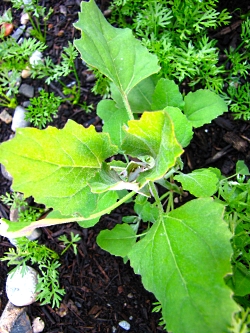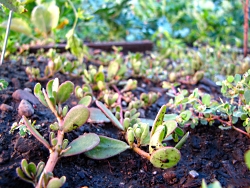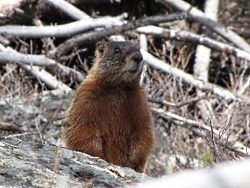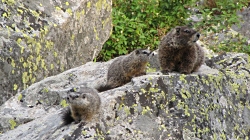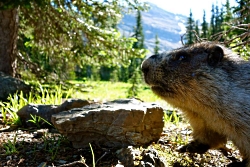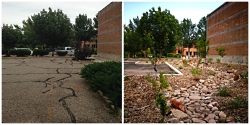
Permaculture Rain Garden
USU Moab
Photo Courtesy & © Roslynn Brain McCann, Photographer
Alongside planting the rain through water harvesting earthworks, we installed an ecological design with a fruit and shade producing overstory, and an understory of shrubs, plants, and grasses. The understory performs one or more of four functions: pollinator attractors, nitrogen fixers, nutrient accumulators (which pull nutrients deeper in soil layers towards the surface, becoming available through a chop and drop technique), and soil stabilizers. Now, broad-tailed hummingbirds, spotted towhees, rock wrens and more can be seen and heard as the garden bounty ripens each year. These birds bring color, song, and delight as they contribute to pest control, devouring aphids, grasshoppers and pesky plant eating beetle grubs.
What we have learned through our small urban campus is that with permaculture design, any landscape can undergo a complete ecological transition – even a landscape that is only a few feet wide and was previously partially covered in concrete.
If you are interested in applying permaculture design to your landscape, start by observing your site as it currently is. See how water flows in a rain event. Walk around during the hottest days of the year and feel where the hot and cool zones are. How does the sun move across the site during summer solstice. During winter solstice. What views do you want to take in and block? What species engage in your landscape and what ones are missing? These are the types of questions you can ask yourself. Then, as you begin to think about design ideas, here are some general tips:
- Ask elders in your community about extreme weather events and other helpful historical information
- Think about what your landscape is currently doing for you, and what you would like it to do. Then, develop your goals for the site. This will help you determine what is and is not currently working
- In the desert, as a general rule, place your paths high and dry, plants low and wet (or at least wetter)
- Discover what plants might work well together in what is called a guild. For example, if you have a nitrogen dependent shrub, plant nitrogen-fixing plants around it.
- Harvest as much rainwater as possible through active systems like rain tanks, and passive systems like earthworks that slow, spread, and sink rainwater
- Plant your high-maintenance plants in your most-frequented areas – alongside the pathway between your house and chicken coop, for example.
- Birds and humans appreciate diversity in heights, species, and food-producing plants
- Start small
- See failures as opportunities for learning
For Utah State University Extension Sustainability and the Department of Environment and Society, this is Roslynn Brain McCann and I’m wild about Utah!
Credits:
Images: Courtesy and copyright Roslynn G.H. Brain McCann, Photographer
Audio: Courtesy and copyright Kevin Colver
Text: Roslynn G.H. Brain McCann, Utah State University Extension Sustainability
Additional Reading: Lyle Bingham, Webmaster
Additional Reading:
Brain McCann, Roslynn G.H., Rainwater Harvesting, Wild About Utah, October 19, 2015, https://wildaboututah.org/rainwater-harvesting/
Brain McCann, Roslynn G.H., Permaculture, Wild About Utah, May 23, 2016, https://wildaboututah.org/permaculture/
Brain McCann, Roslynn G.H., Three-Leaf Sumac (Rhus trilobata), Wild About Utah, November 23, 2015, https://wildaboututah.org/three-leaf-sumac-rhus-trilobata/
Brain McCann, Roslynn G.H., Dandelion, Friend or Foe?, Wild About Utah, April 4, 2016, https://wildaboututah.org/dandelion-friend-foe/
Brain McCann, Roslynn G.H., Edible Weeds: Lambs Quarters and Purslane, Wild About Utah, March 27, 2017, https://wildaboututah.org/edible-weeds-lambs-quarters-and-purslane/
Brain McCann, Roslynn G.H., Yellow-bellied Marmot, Wild About Utah, September 21, 2015, https://wildaboututah.org/yellow-bellied-marmot/
YCC Team, Lush Utah garden makes the most of a small amount of rain, Yale Climate Connections, July 25, 2022, https://yaleclimateconnections.org/2022/07/lush-utah-garden-makes-the-most-of-a-small-amount-of-rain/

